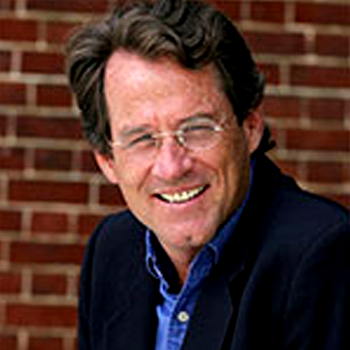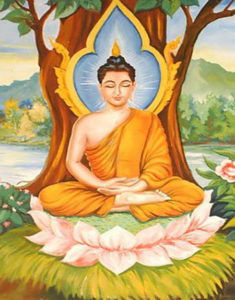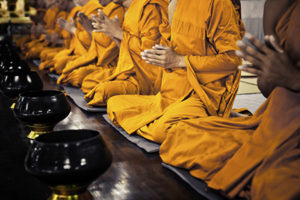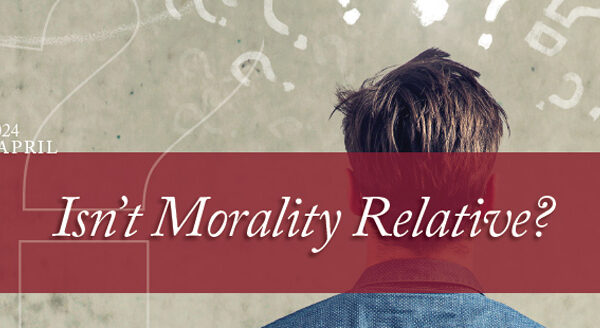Back to series



Download or Listen to Audio
A Thumbnail Sketch Of Buddhism For Christians
Click here to open a Print - Friendly PDF
Buddhism is popular among college students and educated skeptics today. I think there are a number of reasons for this. One is that the Buddha’s search for truth and his willingness to forsake the world strike chords in young seekers who recognize the emptiness of materialism. It is also attractive to those who have been turned off to Christianity, for one reason or another, and want some sort of spiritual alternative.
Facts on the Ground
Let’s start with numbers and places. How many Buddhists are there, and where do they live?
Today there are about 400 million Buddhists, or 6 percent of the world’s population. Estimates of the number of Buddhists in the United States range from 1.5 to 2 million. Of those 75 to 80 percent are Asian.
Those who follow Theravada, which is the school of Buddhism closest to the teachings of Gotama Buddha, the founder, are located primarily in Southeast Asia: Sri Lanka, Myanmar, Cambodia, and Thailand. The Mahayana school, which may have started later in China and became more popular, is prevalent in China and East Asia (Japan and Korea). Zen Buddhism was started in Japan and has spread west, while Tibetan Buddhism is of course centered in that mountainous land bordering China but has become popular around the world because of the Dalai Lama’s attractive persona and teaching.
The Story of the Buddha
Siddhartha Gotama Buddha (ca. 448–368 BC) grew up in the lap of luxury.
He was the son of a king in the mountain fastnesses of what is now Nepal. Not unnaturally, he was indulged by his father. But Gotama’s environment went far beyond what we would imagine. Apparently in an attempt to keep his son fast bound to himself, Gotama’s father made sure the boy never saw suffering and deprivation, old age, disease, and death. It’s hard to imagine how Gotama could never have seen or known of death, but so the story goes.
 At some point in Gotama’s twenties, reality broke through. On the first of several chariot rides, Gotama saw an old man. “Oh no!” he exclaimed. “Do you mean I will someday suffer like that?!”
At some point in Gotama’s twenties, reality broke through. On the first of several chariot rides, Gotama saw an old man. “Oh no!” he exclaimed. “Do you mean I will someday suffer like that?!”
Then on a second chariot ride, he saw a sick person obviously distressed by pain. This opened his eyes to the pervasiveness of suffering in the world. Gotama was sorely distressed.
A third chariot ride brought the sight of a corpse in a funeral procession. This too alarmed Gotama. “What? We don’t live forever?!” The young man sunk into despair. Life seemed hopeless.
But then another sight some time later brought him hope. This time he saw a figure on the horizon walking in a saffron robe. It was probably a Hindu sannyasi, a holy man practicing asceticism and meditation in the quest of moksha (liberation from the cycle of reincarnation).
“Who is that?” he asked his driver.
“Oh, he’s seeking the way beyond life and death,” he was told—meaning that this Hindu seeker was trying to reach the state where he would not be reborn into another life in this world, but be joined with Brahma, the impersonal Absolute. But for Gotama, this meant there might be a way to avoid the suffering of life and death.
By this time in his life, Gotama was married and had a son. But the Four Sights (of age, disease, death, and the way beyond death) made him reconsider his direction in life. At the age of twenty-nine, he decided he would follow the way of the sannyasi he had seen. Gotama left his wife and son and set off into the wilderness.
Some explanation is needed here: this was a religious tradition back then, and he left his wife and son in the care of his larger family. They probably believed this would give them good karma (lit., “deeds” which would help produce a better reincarnation). But we are also told that his wife was angry with him for leaving them. This departure is called the Great Renunciation.
Gotama made drastic changes, following what the Hindu traditions were telling him then—practice asceticism and meditate until you are enlightened. He embraced this new life so radically that he was reduced to skin and bones. We’re told that when he put his hand on his stomach, he could feel his backbone.
But it didn’t work. Enlightenment never came.
So Gotama decided he would take the bull by the horns, as it were, and demand results. He would sit under a tree (later it became known as the Bodhi or enlightenment tree) until revelation came.
He sat all day and evening and night until . . . finally enlightenment came. During the early morning hours, he was given revelation after revelation after revelation. He saw all the truths of reality, which he would teach for the next fifty-odd years until his death from food poisoning. He had come to be free of all desire and so achieved, after this one night, nirvana (lit., the “blowing out” of desire).
The Buddha’s Teachings
That night the Buddha saw what Buddhists have ever-since called Four Noble Truths. The first is that all is suffering. This doesn’t mean that every minute of the day we feel bad. Christians can understand its meaning: that at the deepest level all of life is dissatisfactory. Even when we’re having fun and being successful, we know deep inside that there is something missing—if we haven’t found spiritual Reality.
The second Noble Truth is that the cause of suffering is desire. The Buddha (now we can use this title, for it means “the enlightened one”) said there are three desires humans feel: desire for sensual pleasure; desire for becoming someone recognized and esteemed; and desire for nonbecoming or suicide.
He recognized that most of us do not feel the third desire most of the time.
The Buddha said there is a reason we are filled with these desires: our ignorance. Hindus also see ignorance as our central problem. But while Hindus feel we are ignorant of Brahma or a personal god, Gotama Buddha said we are ignorant of the Three Characteristics of Existence.
The first is impermanence. This means that nothing ever remains the same—even Brahma, which was the philosophical Hindu idea of ultimate reality.
Hindus said this is the only unchanging reality. The Buddha rejected this. He said nothing is permanent, everything is constantly changing. This also meant there is no unchanging substance behind and within anything in the cosmos, so nothing has independent existence.
Christians can agree with this in part, for they say that nothing exists apart from God. There is nothing that exists on its own. But the Buddha rejected the idea of a Creator God who is responsible for all things. He said there are gods, but that these are not creators and certainly not redeemers, and that they need to attain the same enlightenment as us humans. So, for all practical purposes, the Buddha was an agnostic.
He said he didn’t know if there was a supreme god, which is what agnostic means—“I do not know.” In any event, he did not believe in a God who created the world and now controls it. And he looked not to a god but to his own self for any sort of “salvation.”
The second Characteristic of Existence is suffering, which we have already seen is the first Noble Truth. The third is that there is no self. This follows from the first Characteristic, that everything is impermanent. Let me try to explain.
If there is nothing permanent in Jane, let’s say, then there can’t be anything that remains the same from year to year, month to month, or even moment to moment. Can that be? Well, we know that our atoms and cells are constantly changing, so at the level of the body, that must be true; there is nothing permanent.
What about Jane’s mind? Her thoughts are constantly changing, especially as she experiences new things, which she does during her waking hours and when she is dreaming. If her experiences are constantly giving her new perspectives, how can her mind remain the same? You say her basic attitudes are the same? But how can they be? If her perspective is constantly changing (even if minutely) because of her new experiences, then even her attitudes change with an ever-changing perspective. They may not change much, but they change nevertheless.
If Jane’s mind and body are constantly changing, we’d have to say the same about her emotions and will. As life brings new things, good and bad, her feelings go up and down. And her desires, expressed by her will, must also change apace.
If Jane’s mind, body, feelings, and will continually change, then there can’t be anything about her that remains the same. And what is the self but the combination of mind, body, feelings, and will? Therefore Buddhists say Jane has no self—at least one that remains the same across time.
By the way, the Buddha said that as long as we think we have a permanent self, we will be all the more attached to this self and unable to give up desire—which keeps us suffering and stuck in samsara, the endless cycle of reincarnation. So knowing that we have no permanent self is part of our liberation. It helps us get rid of desire, which in turn helps us attain nirvana (more on that in a bit).
Let’s take stock of what we have learned so far about the Buddha’s teaching. All is suffering (the first Noble Truth), the cause of suffering is desire (the second Noble Truth), which comes from ignorance of the Three Characteristics. Now we must go on to the third Noble Truth: the way to be rid of suffering is to be rid of desire. The eventual “blowing out” of desire is nirvana, which is a state of cessation of suffering that can be experienced at one level in this life and at another level after death.
 The nirvana in this life is called “nirvana with remainder,” and that in the next is “nirvana without remainder.” The “remainder” refers to karma, which are deeds that keep us in this cycle of reincarnation (samsara). Nirvana in the next life, without remainder, is nothing like anything we can imagine. In fact, the Buddha taught that in nirvana there are no desires, thoughts, or beings. So we have to say that nirvana is the end of human existence as we know it.
The nirvana in this life is called “nirvana with remainder,” and that in the next is “nirvana without remainder.” The “remainder” refers to karma, which are deeds that keep us in this cycle of reincarnation (samsara). Nirvana in the next life, without remainder, is nothing like anything we can imagine. In fact, the Buddha taught that in nirvana there are no desires, thoughts, or beings. So we have to say that nirvana is the end of human existence as we know it.
Perhaps it is like that drop of water that hits the surface of the ocean and in a matter of milliseconds no longer exists as an individual drop. Its contents have dispersed and merged with the ocean. The “I” is no longer a being (of course it never was a self anyway!), but that’s not the important thing for the Buddha. The important thing is that suffering is over, which is the goal of the Buddha’s teaching.
The fourth Noble Truth is this: The way to be rid of desire is to follow the Noble Eightfold Path. The first step on that path is right understanding. This means proper understanding of the Buddha’s teachings, such as the four Noble Truths and three Characteristics of Existence.
Don’t believe anyone who says something like the following: “In Buddhism (as opposed to Christianity) it doesn’t matter what you believe, all that matters is what you do.” You can see from this first step on the Noble Eightfold Path that it matters very much what you believe. If you do not believe what the Buddha taught about suffering and the self, for example, you will not make it past square one in Buddhism.
The second step is right thinking, which involves thinking about truth (the Buddha’s teachings again) and not how to build up your own self, for that just increases desire. The third step is right speech, which means no lying or slander or gossip. Right action (the fourth step) means following the Five Precepts: no killing, stealing, sexual sin, lying, or alcohol. Let me explain some of those.
No killing means just that—the taking of life, even animal life, is forbidden. So consistent Buddhists are vegetarians and pacifists. That does not mean that Buddhists never eat meat or fight in war, any more than that Christians have always forgiven their enemies. But those are the ideals.
Sexual sin means sin outside of marriage for laity, and any sex at all for Buddhist monks and nuns. Notice, by the way, that Buddhist ethics are very similar to Christian moral rules. The same is true for the other major religions.
Christians differ on application and interpretation, but the same basic principles—actually, those of the Ten Commandments—are taught by all the major religions. As C.S. Lewis once said, if you went to the British Museum (which is a library) to research the moral teachings of the great civilizations, you’d get bored after three days, for they all say nearly the same things. He pointed this out in “Illustrations of the Tao,” the appendix to his book The Abolition of Man.
“Right action” (the fourth step on the Noble Path) also includes the four Unlimited Virtues (friendliness, compassion, sympathetic joy, and even-mindedness). The last virtue means remaining even-keeled even in times of suffering and joy. This, Buddhists say, is possible only after meditation.
The fifth step is right livelihood. That means some occupations are obviously forbidden to the faithful Buddhist: arms sales, butchering animals, producing intoxicants.
The last three steps (right effort, right mindfulness, and right concentration) all have to do with meditation, which is the Buddhist way par excellence to spiritual advancement.
The Buddhist School Closest to the Root: Theravada
There are four main schools of Buddhism—Theravada, Mahayana, Zen, and Tibetan. Here and below we will discuss the first two, which are the largest.
Theravada, which is Pali for the “Way of the Elders,” took most of its present shape by the second century BC, about two centuries after the death of the Buddha. Of the four schools just mentioned, it is probably closest to what historians think Gotama actually taught.
Its chief goal is liberation from samsara in nirvana, which, as we saw earlier, is the end of consciousness and individuality. The Theravada school regards the gods as real but unhelpful in the human search to end suffering.
It says the human self is unreal and lives many lives in many heavens and hells before it reaches nirvana; most of us are not spiritual enough to have attained nirvana before the end of one life. It says the world is not a thing but a process, with no beginning or end. Remember here the Buddha’s teaching that nothing is permanent and standing on its own. So too for the world.
According to Theravada, the basic human problem is suffering in samsara because of ignorance of the Buddha’s teachings. That ignorance creates desire, which in turn is responsible for our suffering. The resolution to our problem(s) is to accept what the Buddha taught and practice his virtues and precepts.
Some have asked how this can be a religion. For it doesn’t have the earmarks of what most of us think of when we hear the word religion. There is no worship, for there is no God who made us or the world or will save us. Neither are there prayer or praise, forgiveness or heaven. Judgment and a final hell are missing. The Buddha was always silent about the future life, except to say what it is not—a place of beings, consciousness or desire.
But in another sense it is a religion. It is a complete way of thinking and practice that answers (or at least struggles with) the most important questions in life: Who or what are we? Where did we come from? Where are we going? How should we live our lives?
In this sense, of course, even atheism is a religion, for it too answers these questions.
This may seem odd to you, to call atheism and this kind of Buddhism “religions” when they don’t purport a belief in God. But it does help explain how Theravada (and other kinds of) Buddhists can feel religious and look toward reality with reverence without believing in a personal god.
Mahayana: The Largest and Most Popular School
The first Mahayana (Sanskrit for “Great Vehicle,” which suggests it carries many more than its rival Theravada) sutras (scriptures) were written between the first and eighth centuries AD. In them one can see distinct departures from Theravada positions. Here are the most important differences:
1. Universalism. Whereas in Theravada male monks have been the only ones considered spiritual enough to attain nirvana, Mahayana promises the possibility of liberation for everyone.
2. Fast and easy. In Theravada liberation takes many lives (in samsara, the reincarnation process), but Mahayana promises liberation after only one life. And it doesn’t take lengthy, rigorous meditation; in some Mahayana schools, if you simply look with sincere faith one time during your life to the Buddha, you will escape samsara after death. It’s no wonder Mahayana is the largest and most popular segment of Buddhism.
3. Buddha as god. While Theravada teaches that the Buddha was just a man, Mahayana talks about the divine Buddha, and de-emphasizes the historical Gotama.
4. Many Buddhas. Theravada focuses on the one Buddha in history, Gotama. But Mahayanists speak of an infinite number of Buddhas. And Mahayana teachers also say each one of us has a latent Buddha nature, so that we are all unrealized Buddhas.
 5. Grace. The Mahayana ideal figure is the bodhisattva (Sanskrit for “a being for enlightenment”) who was on his way to Buddhahood but stopped to help those still ignorant and suffering in samsara. The bodhisattva is said to have one foot in our world and one in nirvana. He keeps the one foot here so that he can impart grace to those who need it.
5. Grace. The Mahayana ideal figure is the bodhisattva (Sanskrit for “a being for enlightenment”) who was on his way to Buddhahood but stopped to help those still ignorant and suffering in samsara. The bodhisattva is said to have one foot in our world and one in nirvana. He keeps the one foot here so that he can impart grace to those who need it.
The most important bodhisattva is Amitabha (in Japan, Amida), who in the distant past said he would bring to his Pure Land all who called on his name in faith. He forgives their sins because of their faith and saves them from more lives in samsara. Strictly speaking, however, these bodhisattvas are already Buddhas.
6. Levels of truth. Mahayana Buddhists talk about levels of reality and truth. The earthly Buddha, Gotama, is at the lowest level. Above that are the paradisal heavens that are full of Buddhas and bodhisattvas. Each one of the latter is a bodily form of what they call “absolute Buddha nature.”
Then at the highest level is the ultimate nature of reality, which is nirvana. This is nondual, which means that there are no distinctions in it. All is one. Nothing separates anything from anything else. There are no individuals here. What we think of as the human self is lost in the ocean of the ultimate Oneness, like the drop of water that hits the surface of the ocean.
Christian Analysis
I think you can see that Jesus and the Buddha were very different. The most important difference is that the Buddha did not believe in a God as we know it (he was agnostic on that) and certainly didn’t know the triune God. Later Mahayana traditions came to believe in deities known as Buddhas and bodhisattvas, but Gotama Buddha said that he was no more than a man, and that there is no Creator or divine being who can help us achieve our spiritual goals.
This is why Sakyamuni, as the original Buddha is known by many Buddhists, said that we are to be lamps unto ourselves. In contrast, Jesus said that He was the light of the world.
We Christians say that we are not on our own, as the Buddha suggested, but can ask for the grace of Jesus to do for us what we cannot do. While Jesus emphasized moral corruption as the heart of the basic human problem (Mark 7:20–23), the Buddha said desire—for gratification of one’s senses and one’s ego—is the root of all suffering.
With love one can become a bodhisattva, but only knowledge enables one to become a Buddha. Perhaps as a result, Buddhist and Christian portrayals of the spiritual ideal are curiously different: Buddhists look to a smiling Buddha seated on a lotus blossom, while Christians worship a suffering Jesus nailed to a cross.
The Buddha taught his followers to escape suffering, while Jesus showed a way to conquer suffering by embracing it.
Although Buddhist and Christian ethics agree on important principles (that stealing, lying, the killing of innocent life, and sexual misconduct are wrong, and that compassion and sympathy are imperative), they differ on the relationship of ethics to ultimate reality.
For Gotama Buddha and Theravadins the ethical life is a provisional raft that takes us to the other shore of nirvana, where it can then be discarded. For in nirvana differences between good and evil no longer exist. But for Christians, the distinction between right and wrong is part of the fabric of reality and will persist into eternity.
Ethical differences extend to relations between the sexes. In early Buddhism particularly you find the idea that you can become a Buddha only if you’re reborn in the form of a man. Not until much later did Mahayanists accept female bodhisattvas. Buddhist monasteries today dominate Theravadin life; most orders for nuns disappeared centuries ago.
While Christian history contains plenty of sexism, Jesus Himself never demonized women or sexuality. When compared to the rigid structure of Buddhist monasticism, which is at the heart of Theravada, Jesus’ circle of disciples appears casual and free.
 Buddhists and Christians look at ethics differently in large part because they regard history in radically different ways.
Buddhists and Christians look at ethics differently in large part because they regard history in radically different ways.
Buddhists read in the Dhammapada that “there is no misery like physical existence” (15.6).
Earthly existence is necessarily a vale of tears, because as long as one remains in the endless cycle of life, death, and rebirth (samsara), suffering is inevitable because of the desire that life in this world produces.
We’re told we can escape suffering only by escaping this wearisome cycle of rebirth. So we have to break ties to this world and its routines, particularly family life and sexuality.
Jesus, however, never spoke harsh words about sexual intercourse. He announced a salvation that comes not by renouncing life in the world but by trust that is lived out in loving commitment amid the everyday routines of worldly life. According to Him, marriage is not an impediment to spirituality but the ordinary realm in which salvation is lived out. Abstention from family and sexuality is an option, but not a higher path for the spiritual elite.
At the same time I should say that this contrast should not be drawn too sharply. Christian monasticism has at times been just as world denying as its Buddhist counterpart. Beginning with the apostle Paul (1 Cor. 7), there have been many Christians who have concluded that they could find God best apart from family and sexuality.
And while monasticism has been more integral to Theravada than Christianity, Jesus Himself chose not to marry or regard family as the center of the spiritual life (Matt. 10:37; 12:49–50), and the vast majority of Buddhists enjoy the fullness of married life and participation in the secular world.

There’s one final difference, and one of the most important: hope. If you are following the teachings of the original Buddha—Siddhartha Gotama—you have little or no hope for life after death. Sure, you can hope for nirvana, but this is a realm in which “you” are no longer a “you.” There is no individual self there in which to enjoy freedom from suffering.
Jesus, however, gives us the promise of eternal life as an individual self but joined to Him and the Father and the Spirit, in fellowship with the millions and perhaps billions of other saints—not only family and friends but the saints throughout history. And that fellowship, with joy and learning, will continue through all eternity.
The contrast is more than enormous.

Gerald McDermott
ProfessorGerald McDermott, Professor, is a retired Anglican Chair of Divinity at Samford’s Beeson Divinity School. Prior to that, he served as Jordan–Trexler Professor of Religion at Roanoke College and taught for 26 years. He grew up in Boston, New York and Philadelphia, went to a Jesuit high school in New York City, graduated from the University of Chicago (B.A., New Testament and Early Christian Literature). He lived in religious communes for seven years, started and ran a private school for three years, pastored for five years in Iowa, and earned a Ph.D. in religion at the University of Iowa.

 COPYRIGHT: This publication is published by C.S. Lewis Institute; 8001 Braddock Road, Suite 301; Springfield, VA 22151. Portions of the publication may be reproduced for noncommercial, local church or ministry use without prior permission. Electronic copies of the PDF files may be duplicated and transmitted via e-mail for personal and church use. Articles may not be modified without prior written permission of the Institute. For questions, contact the Institute: 703.914.5602 or email us.
COPYRIGHT: This publication is published by C.S. Lewis Institute; 8001 Braddock Road, Suite 301; Springfield, VA 22151. Portions of the publication may be reproduced for noncommercial, local church or ministry use without prior permission. Electronic copies of the PDF files may be duplicated and transmitted via e-mail for personal and church use. Articles may not be modified without prior written permission of the Institute. For questions, contact the Institute: 703.914.5602 or email us.
-
Recent Podcasts
A Welcome Change in Apologetics
by Randy Newman, Aimee Riegert on April 19, 2024We’re burdened for our friends who don’t know...Read More
-
Questions That Matter Podcast – Samuel James and Digital Liturgies
by Samuel James, Randy Newman on April 19, 2024
-
The Side B Stories – Dr. James Tour’s story
by Jana Harmon, James Tour on April 12, 2024
-
Recent Publications
Isn’t Morality Relative?
by Christopher L. Reese on April 1, 2024It is widely accepted in the Western world...Read More
-
Do Muslims and Christians Worship the Same God?
by Andy Bannister on March 1, 2024
-
Artificial Intelligence and Its Impacts on Humanity
by John Lennox on February 13, 2024
0
All Booked
0.00
All Booked
0.00
All Booked
22140
GLOBAL EVENT: Keeping the Faith From One Generation To Another with Stuart McAllister and Cameron McAllister, 8:00PM ET
https://www.cslewisinstitute.org/?event=global-event-keeping-the-faith-from-one-generation-to-another-with-stuart-mcallister-and-cameron-mcallister-800pm-et&event_date=2024-05-17®=1
https://www.paypal.com/cgi-bin/webscr
2024-05-17

Next coming event
Days
Hours
Minutes
Seconds
GLOBAL EVENT: Keeping the Faith From One Generation To Another with Stuart McAllister and Cameron McAllister, 8:00PM ET
On May 17, 2024 at 8:00 pmSpeakers

Gerald McDermott
Professor
Team Members

Gerald McDermott
ProfessorGerald McDermott, Professor, is a retired Anglican Chair of Divinity at Samford’s Beeson Divinity School. Prior to that, he served as Jordan–Trexler Professor of Religion at Roanoke College and taught for 26 years. He grew up in Boston, New York and Philadelphia, went to a Jesuit high school in New York City, graduated from the University of Chicago (B.A., New Testament and Early Christian Literature). He lived in religious communes for seven years, started and ran a private school for three years, pastored for five years in Iowa, and earned a Ph.D. in religion at the University of Iowa.





